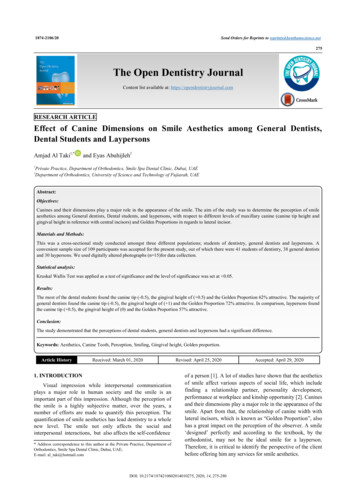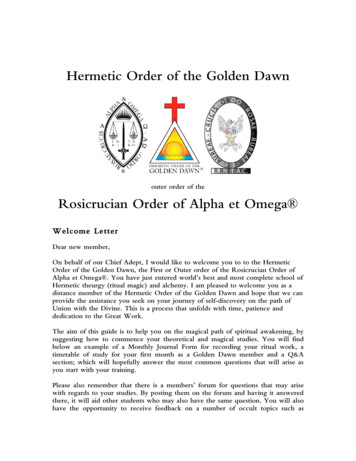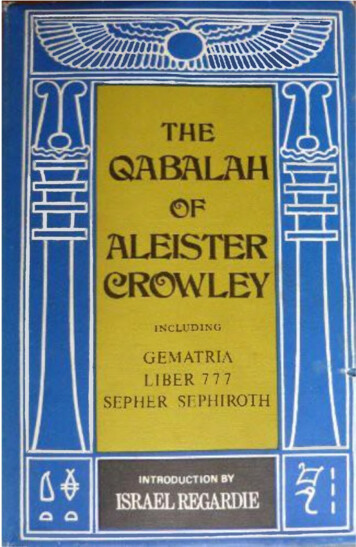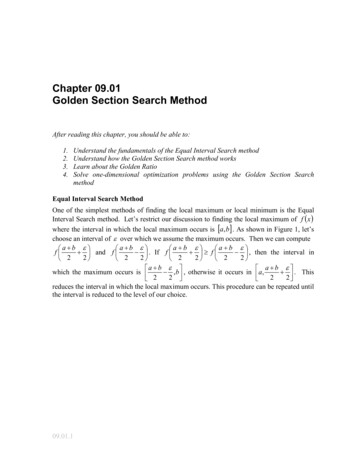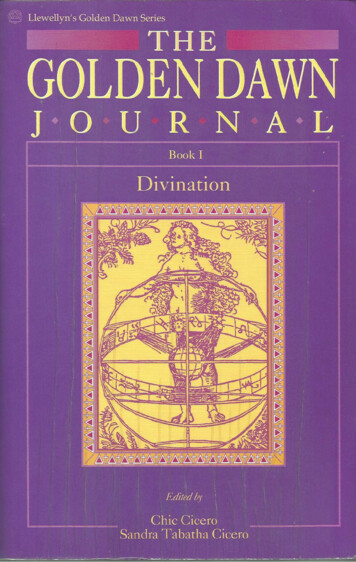
Transcription
THE GOLDEN DAWN LIVES!As both an order and a magical tradition in the 19th cen tury, the Hermetic Order of the Golden Dawn is responsi ble for planting the seeds of magic that today have sownmagical organizations throughout the world. The GoldenDawn and its reverberating facets are now meticulouslydepicted in the ongoing series The Golden Dawn Journal.Book One: Divination explores the underlying mechanismand methods of divination , including those most favoredby the Golden Dawn. As "divination is the process ofestablishing communication with the Gods of the collectiveunconscious" (Steven Marshall), Book One reveals how,when, and why the divinatory process works and exam ines whether or not it can always be trusted. Included inthis fascinating foray are explorations into psychologicalconsiderations in divination, particular forms of divinationand particular methods within those forms. Book Onedelves into all aspects of ceremonial magic and theHermetic Tradition, including Tarot readings from meet ings of the original Golden Dawn members!The Golden Dawn Journal, Book One presents the world'sbest known occult and magical organization in. a clearand practical way, providing a vehicle for communication,exploration and discussion for anyone interested inunderstanding the universe and his or her role in it.
About the EditorsBoth Chic and Tabatha are Senior Adepts of the HermeticOrder of the Golden Dawn, the only such group operating inthe United States and Canada that has a Vault which was con secrated by Israel Regardie and into which Regardie performedinitiations for the purpose of establishing a Second Order withvalid initiatory succession from the original Mother temple inLondon. They are the authors of The New Golden Dawn RitualTarot (deck and book) and Secrets of a Golden Dawn Temple.To Write to the EditorsIf you wish to contact the editors or would like more infor mation about this book, please write to the editors in care ofLlewellyn Worldwide and we will forward your request. Boththe editors and publisher appreciate hearing from you andle arning of your enjoyment of this book and how it hashelped you. Llewellyn Worldwide cannot guarantee thatevery letter written to the editors can be answered, but allwill be forwarded. Please write to:Chic Cicero and Sandra Tabatha Ciceroc/o Llewellyn WorldwideP.O . Box 64383-850, St. Paul, MN 55164-0383, U.S.A.Please enclose a self-addressed, stamped envelope for reply, or 1.00 to cover costs.If outside U.S.A., enclose international postal repy coupon.Free Catalog from LlewellynFor more than 90 years Llewellyn has brought its readersknowledge in the fields of metaphysics and human potential.Learn about the newest books in spiritual guidance, naturalhealing, astrology, occult philosophy and more. Enjoy bookreviews, new age articles, a calendar of events, plus currentadvertised products and services. To get your free copy ofLlewellyn's New Worlds of Mind and Spirit, send your nameand address to :Llewellyn's New Worlds of Mind and Spirit64383-850, St. Paul MN 55164-0383, U.S.A.P. O . Box
THEGOLDEN DAWNJOURNALBook 1DivinationEdited byChic CiceroSandra Tabatha Cicero1994Llewellyn PublicationsSt. Paul, Minnesota 55164-0383
The Golden Dawn Journal, Book 1. Copyright 1994 by Chic Ciceroand Sandra Tabatha Cicero. All rights reserved. Printed in the UnitedStates of America. No part of this book may be used or reproduced inany manner whatsoever without permission in writing from LlewellynPublications except in the case of brief quotations embodied in criticalarticles and reviews.FIRST EDITION1st Printing, 1994Cover design by Chic and Sandra Tabatha CiceroColor for cover design by Christopher WellsISBN 1-56718-850-8Permissions:Cross and Triangle artwork copyright Sandra Tabatha CiceroArchangel drawings copyright Sandra Tabatha CiceroHieroglyphic chart copyright M. Isidora ForrestIllustration for article entitled "What to do for an OracleAddiction" copyright Lloyd NygaardSections from the letters from Miss Annie E.F. Horniman to W.B.Yeats containing her Tarot readings as found in MS 18,3 12 arereproduced thanks to the Council of Trustees of the NationalLibrary of IrelandIllustrations of the Tarocco Italiano fabrica del Dotti Milano, 1845,copyright 1985 are reproduced by permissions of OsvaldoMenegazziArticle copyright Gareth KnightArticle copyright Dolores Ashcroft-NowickiArticle and diagrams copyright Adam ForrestLlewellyn PublicationsA Division of Llewellyn Worldwide, Ltd.P.O. Box 64383, St. Paul, MN 55 164-0383Printed in the United States of America
This book is dedicatedto those Initiates who were presentat a very special event:The consecrationof the Vault of the Adeptiby Israel Regardie(Isis-Urania Temple, Georgia-1982).L.V. X.
Forthcoming Books inThe Golden Dawn Journal SeriesQabalah: Theory and MagicThe Art of HermesThe Magical PantheonsEgyptian MagicThe Invisible TempleThe Hermetic GoddessCross and TriangleOf Planets and AngelsEnochianaAlchemy
CONTENTSPreface .iIntroduction. 1The Psychology of Divinationby Steven Marshall .9Divination & The Magical Tarotby Gareth Knight .19The Golden Dawn Method of Tarot Divinationby Cris Monnastre . . .35The Abbey Theatre Tarot Readingsby Mary K. Greer .75Spiritual Tarot and Circle Spread Divinationby Frater P. C. .93The Divination of the Rose Crossby Donald Michael Kraig . 107Taro-strology: The Tarot Wheel of the Yearby Thom Parrott . .123By the Signs of the Earth: Geomancy in the Golden Dawnby Mitch & Gail Henson . 145Mysteria Geomantica: Teachings on the Art of Geomancyby Adam P. Forrest . . .177From God to My Soul: Reading the Auspicesby David Godwin ., .203Divination in the Grreco-Egyptian Magical Papyriby M. Isidora Forrest . . .213The Gypsy Runesby Dolores Ashcroft-Nowicki .231Ceremonial Archangelic Divinationby Oz.239What to Do for an Oracle Addictionby Madonna Compton . . . .255Towards a General Theory of Divinationby Sam Webster. . . .265The Editor's Forum:Can a Divination Always be Trusted? .275
llPrefacehe Golden Dawn Journal is an ongoing series of booksdesigned to reflect the magical teachings and philo sophy of the Hermetic Tradition. Each issue of TheJournal will focus on articles written by variousauthors who have had experience in Western ceremonialmagic; particularly the type of magic espoused by the HermeticOrder of the Golden Dawn and its off-shoots.As an Order and a magical tradition, the Golden Dawn isresponsible for planting many of the seeds of knowledge thathave spouted today in the form of numerous magical organiza tions throughout the world. Few could argue against the factthat the teachings of the Golden Dawn were fundamental tomuch of what now constitutes 20th Century magic. One of thetasks of The Golden Dawn Journal will be to provide a surveyof historical and contemporary Golden Dawn magic, with somearticles comparing Golden Dawn techniques with those ofother magical traditions. The Journal will concentrate onserious exploration of the techniques used in the HermeticTradition, as well as an investigation into the archaic roots ofceremonial magic. Practical advice for the working magicianwill be featured.Another reason for presenting The Journal series is toprovide readers with articles on subjects which may not beexclusively concerned with the Golden Dawn, but which arenonetheless of interest to Hermetic students. The focus of sucharticles as these will not be so much with Golden Dawn contentas with Golden Dawn perspective. The Journal will expressthe views of many of today's practicing Golden Dawn magi cians, as well as respected occultists from outside of the Order.M any of today's magical groups have their roots in theix
XTHE GOLDEN DAWN JOURNALHermetic Tradition, and The Journal will explore the parallelideas and views common to all. By showcasing these sharedideas, as well as new Golden Dawn rituals and informationfrom respected sources, The Golden Dawn Journal will confirmthat the Golden Dawn system of magic, far from becomingobsolete and stagnant, is in fact alive and well and providingnew vitality for modern students of the Western EsotericTradition. It is our belief that the willingness to share ideas isimportant for the spiritual growth of magical groups and in dividuals alike. For we are all neophytes of the Hermetic Arts,and what we seek is the One Truth, the Quintessence, theSummum Bonum, the Stone of the Wise.- Chic Cicero
Introductionhy should a highly respected organization like theGolden Dawn, credited as a leading authority inspiritual development, teach its students the art ofdivination, which some see as a low occult practice?The answer is clear enough to anyone who has ever contem plated the images of Divine Beings in the starry night sky orheard the whisperings of Nature Spirits from a river, coolbreeze or wooded hillside. There is no part of us that is not ofthe Gods, for as Hermes taught, "As above, so below." Thatstatement is one of the Truths that we, as magicians, live by.The Universe that we live in is Divine. Every blade of grass,every least bacterium, and even the lowly gravel in your drive way exists through the Creative Will of the Divine. No eventthat occurs in a Divine Universe comes about by chance ormere coincidence, even if its reasons and results are beyondour ability to comprehend it. Nothing in a Divine Universe iswithout meaning or significance.The word divination is based upon the Latin word divina tio which means, "the faculty of foreseeing." The root word isitself based upon the Latin word for "divine power" or "of theGods," and thus exposes the meaning of the word divinationwhich is "to make divine." This sheds an entirely different lighton the subject of divination; instead of an anti-logical parody ofscience wrapped in folklore and superstition, we begin to seethe emergence of a spiritual science that deals with discoveringthe Divine significance of "chance" events. And like othermethods included in the magical arts, divination has existed asa tool for psychic well-being and spiritual health long beforethe development of modern psychology (which has often bor-
2THE GOLDEN DAWN JOURNALrowed heavily from the techniques of ceremonial magic putting new names on old magical ideas).To many people in the non-magical world (as well as few inthe magical world) divination is seen as a low form of occultapplication. Divination has received this unjustified reputationfrom those practitioners who have abused it for the usual non Divine reasons: to gain money, power and influence over others.Given the opportunity, some unscrupulous individuals will finda way to corrupt any noble human endeavor in order to enrichthemselves at the expense of others. This should not for onemoment deter the sincere student from full exploration of thedivinatory arts in order to gain a better understanding of theDivine Universe and his/her role in it. Performed correctly andfor the right reasons, divination can open up the mind of thediviner to the wonders of the spiritual realms and an apprecia tion of the subtle framework behind the visible Universe. Inaddition to this, the various methods of divination are amongthe best-known exercises for stimulating and enhancing the fac ulties of intuition, clairvoyance and imagination.The history of divination is as old as humanity's firstawareness of the Divine. Since mankind was first able to dis cern a Higher Power that lay beyond the physical world,humanity has strived to touch upon and communicate withthat Eternal Force that empowers the Universe. Prayers andinvocations to Deities developed out of the human desire totalk to the Divine-to worship the Gods and petition them forfavorable conditions. Ritual trance and meditation developedout of the human desire to receive communications from theDivine; to let the Gods talk to humans and enrich humankindwith a Higher Wisdom. Divination, too, developed as a meansof interaction with the Gods; a method by which one couldinterpret and comprehend the Will of the Divine.The forms of divination that developed were as varied asthe inventive minds from which they sprang. The earliest typeof divination was probably as simple as gazing into a fire, orlistening to the wind. It often did not seem to matter whatform the divination took; it was more important that thediviner be able to quiet the mind enough to attune with theHigher Forces and then perceive certain signs or symbols bymeans of an inner perception or symbolic vision that couldinterpret the Divine implications of the symbols.
Introduction3In the ancient world, atmospheric signs such as rain,wind, and lightning were considering the precursors of majorevents-all of which had Divine implications. In societieswhere warfare against other tribes or nations was a way of life,divination was often employed strategically, to petition theGods' advice on the best course of action to take against one'senemies. One of the earliest recorded forms of such a divina tion used militarily was The Mingling of Arrows mentioned inthe Book of Ezekiel: "For the king of Babylon stood still at thecrossways, at the head of the two ways, in order to resort todivination. He has shaken the arrows. He consulted withimages and looked into the liver." The king put the names ofhis enemies on the arrows, placed them back into the quiver,and shook them up. Whichever arrow he then drew from thequiver, bore the name of the enemy he would attack. (Thesecond type of divination mentioned in the above quote wasextispicy or the inspection of entrails, a rather messy form ofdivination that dated back to a primitive time when nomadictribes would move into a new region; but not before inspectingthe viscera of animals to determine if the surrounding areawas conducive to good health.)Divining Arrows were at one time employed in the greatmosque at Mecca. One arrow was inscribed with the words,"My Lord hath commanded me." On a second arrow was writ ten, "My Lord hath forbidden me." A third arrow was blank. Ifthe first arrow was drawn, the diviner concluded that theenterprise in question had Divine sanction. If the second arrowwas drawn, the opposite conclusion was reached. If the blankarrow was drawn, the divination was started again until adecisive answer was reached.The Casting of Lots or Sortilege was an early eastern formof divination frequently employed to determine a person's guilt orinnocence in a criminal matter. The early Christians andMuslims often divined by opening a holy book (the Bible orKoran) and reading whatever portion of the text first appeared.One rather inventive form of divination practiced inancient times was known as Alectromancy. A circle was drawnon the ground and divided into as many parts as there wereletters in the alphabet. A grain of wheat was then placed onevery letter. Mter several incantations were repeated, a whiterooster was placed within the circle. Wherever the bird pecked
4THE GOLDEN DAWN JOURNALat the grain indicated the letters revealing the name of aperson in question.Crystallomancy, or divination by means of scrying into acrystal ball, precious stone, or mirror was practiced in very earlytimes, and is still a very popular method today. The operatorwould gaze into the object for a considerable period of time, tocompose his/her mind for whatever revelation was forthcoming.Hydromancy was similar to the technique just mentioned,but instead of a crystal ball, the diviner would gaze into a stillpool or bowl of water. A related technique known in Egypt at avery early period was Scyphomancy, or divination by the cup.A cup was filled with wine or some other appropriate beverageand scryed into. Whenever a Divine name was spoken, some ofthe wine was poured on the ground as an offering to the Deity.Geomancy was a form of divination that had connectionswith both the Earth and with astrology. The earliest form ofthis method was the practice of casting pebbles on the groundor poking holes in the dirt from which were determined certaincharacters or figures. These figures were assigned specificastrological principles which had a direct influence on the out come of the divination. Today the figures of Geomancy areusually generated by using pen and paper. Somewhat similarto Geomancy was the practice of Lithomancy, or divination byreading the veins and markings on particular stones.Dactylomancy was a method of divining by rings. A circu lar ring was suspended by a thread within a glass container.Involuntary movements of the diviner's hand would cause thering to strike the glass; one strike for an affirmative answer, ortwo strikes for a negative reply. Modern forms of Dactylomancyinclude the use of a pendulum or the Ring and Disk (a methodpracticed by Adepts of the Second Order of the Golden Dawn).Pyromancy was the art of divining by Fire. When a diviningFire burned quickly and vigorously, it was considered a goodomen. If it was difficult to light or slow to burn, it was considereda bad sign. Sometimes the shape of the flame or the number ofseparate flaming points had a direct bearing on the prediction.Cheiromancy, the reading of lines or ceases on the palm ofa hand, dates back to antiquity and is still popular today. Thesame is true of Oneiromancy, the interpretation of dreams.Many methods of divination preferred today also havetheir roots in ancient times. The I Ching or Chinese Book ofChanges employs dried yarrow sticks or coins to randomly gen-
Introduction5erate one of 64 figures known as "hexagrams," These hexa grams contain certain combinations of cosmic principles thatare symbolic of various physical and psychic situations. Thecasting of Runes, a Norse magical alphabet carved on woodblocks or stones and "thrown" as a divining tool is also quitepopular with today's practitioners. However, the most preva lent form of divination in modern times, especially amongstudents of the Western esoteric teachings is undoubtedlyCartomancy or divination through cards. Most Cartomancersemploy the Tarot, a pictorial book of occult knowledge thatencompasses not only the divinatory arts but also a progressivesystem for spiritual attainment and initiation.Most scholars agree that Tarot was invented in the 14thCentury. However it was not until the 19th Century that themodern Hermetic Tarot fully blossomed under the teachings ofthe Hermetic Order of the Golden Dawn. The various corres pondences between the systems of Tarot and the mysticalQabalah, first surmised by Eliphas Levi, became a greatlyexpanded system of esoteric knowledge under the guidance ofS.L. MacGregor Mathers. In fact, virtually all of the variousoccult sciences taught in the Outer Order of Golden Dawn(Astrology, Qabalah, Geomancy, Tarot, etc.) were incorporatedinto a comprehensive and unified body of knowledge compris ing the Golden Dawn's Inner Order curriculum, which includedEnochian, Assumption of Godforms, Rising in the Planes, andvarious forms of practical ritual work. In order for an Adept tobe able to perform Enochian magic safely and correctly, forexample, s/he had to be quite skilled in the knowledge of Tarot,Geomancy, Astrology and Qabalah. In the higher ritual work ings of the Order, a thorough understanding of all of these"separate" techniques was and still is essential. The correspon dences between each of these methods must become second nature to the magician, who is then able to focus the mind onthe astral manipulations necessary for ceremonial work.The divinatory methods embraced by the Golden Dawn,have become fundamental to the understanding of the DivineUniverse by today's hermetic students. These techniques are nowused by magicians of many different traditions to communicatewith the Creator of the Divine Universe by seeking out know ledge from within. This, too, is a fulfillment of the HermeticAxiom mentioned at the beginning of this introduction, for bylearning how to interpret the subtle cosmic influences within us
6THE GOLDEN DAWN JOURNAL(Man-the Microcosm) we then can leam to interpret those sub tle unseen influences that exist outside of ourselves (theMacrocosm) through a universal law of correspondences.Aside from the employment of certain aspects of divin atory systems within the initiation rites and higher ritualworkings of the Golden Dawn, the science of divination itself istaught primarily through the techniques of Tarot andGeomancy. A basic knowledge of Astrology is also required onthe part of the student. (By comparison, divination byEnochian Chess and by the Ring and Disk of a TheoricusAdeptus Minor plays a lesser role. ) Originally, the GoldenDawn's method of Tarot divination known as the Opening ofthe Key, (fully explained in the article by Cris Monnastre) wasnot taught below the Grade of Adept; Outer Order studentslearned the Celtic Cross method instead. Popularized by A.E.Waite, the simple Celtic Cross Spread is proof that many of thebasic teachings expounded by the Golden Dawn have becomefundamental to virtually all areas of 20th Century occultism.The ability to perform an accurate divination comes easilyto a few, but for most of us it takes a lot of study, practice, in tuition, and a working knowledge of correspondences. Itrequires a balanced approach on the part of the diviner; anapproach that actively involves all parts of the psyche: intellectand emotion, ego and Spirit. The type of divinatory systemchosen is not important. The most essential requirement isthat the diviner should have some basic set of symbols thats/he is thoroughly familiar with, and which express a distinctmeaning. These meanings should be precise and clear, butnonetheless elastic enough to permit the psychic powers of per ception to come into play. The question asked in a divinationshould be precise and to the point, and the selection of symbolsshould always be random in order to engage the subconsciousmind in the interpretive process.In this first issue of The Golden Dawn Journal, we presentseveral articles by various authors on the subject of divin-ation.The topics covered range from: explanations on how and whythe process of divination works, traditional techniques of Tarotand Geomancy (along with new information on both), new Tarotspreads, historical information derived from the actual Tarotreadings of an original member of the Golden Dawn, explor ations of both Roman and Grreco-Egyptian divin-atory tech niques, Gypsy Runes, and new systems of divination developed
Introduction7by accomplished magicians in the field. We also present a sec tion that will become a permanent fixture of The Journal seriesknown as the Editor's Forum, where all of our authors areasked to respond to a specific question that relates to the themeof the current issue. It is our hope that the Forum can supplythe reader with a wide range of opinions and practical advicefrom both working magicians and well-known authorities.It is also our hope that after reading this book, students andInitiates alike are better able to interpret the subtle nuances ofthe Divine Universe in which we live, work, and do magic. Likeany practice that can be either sublimated or abused by its prac titioners, divination should be respected as a powerful tool forpersonal growth and change. Through better understanding ofthe mechanics and philosophy of the art, we trust that the sin cere student will never abase the Divine in divination.- Chic CiceroSandra Tabatha Cicero
The Psychology of Divination Steven Marshalln treading the magical path on the road to wholeness,the goal becomes the process. The Goal of theQuintessence, the Stone of the Philosophers, revealsitself as an interior alchemy of transforming thehuman psyche into the spiritual gold of the enlightened humanbeing. This is the divine art of Hermes, the alchemy of the Self.The process of spiritual growth is not an unconscious one thatwe can rely on nature alone to effect, but one that must beaccomplished through a combination of human artifice andspiritual insight. The development of certain skills, the learn ing of particular knowledge and an understanding of the mys teries of our own psychology constitute necessary resources injourneying the conscious path of spiritual development. One ofthe areas of skill and knowledge prescribed on the magicalpath is the art of divination.The psychological alchemy facilitated by the practice ofdivination provides a key to magical development that canserve the devout seeker throughout the spiritual quest. Theword divination has its root in a Latin word meaning "of theGods." Divination is the process of establishing communicationwith the Gods of the collective unconscious. One of the patronGods of divination is Hermes, the psychopomp of the soul andthe Messenger of the Gods. In myth, Hermes traverses theUnderworld, the Heaven-world and the middle realm ofhumanity. He is the Lord of the Crossroads where these threerealms meet. Thus the art of divination involves a psychologi cal process where the underworld, heavenly and human areasof the psyche come together in a meaningful way.The three levels of the human psyche that are involved inthe practice of divination are called the N ephesh, the9
10THE GOLDEN DAWN JOURNALN eschama and the Ruach in the teachings of the Qabbalah.The Nephesh relates to the animal soul, the subconscious andthe realm of the personal unconscious. The Ruach correspondsto the conscious ego, and the Neschama includes the higherdivine genius, the superconscious and the realm of the collec tive unconscious. The Neschama and the Nephesh both com municate through the language of symbols and images. Theego consciousness communicates primarily through the lan guage of the written or spoken word, the "logos." The Ruachcannot communicate directly with the Neschama, as it mustrely on the Nephesh to convert "the word" into the symbol lan guage that the Neschama can perceive. The Ruach communi cates with the Nephesh by means of words that have emotionalor image-stimulating meaning to the Nephesh, much in thesame way a dog may learn to associate certain words with cer tain behaviors or consequences. The Nephesh is also responsi ble for sensory perception.In a divination, the Nephesh first sends the image of thevisual pattern of the symbols to the Ruach. The Ruach mustthen ask the Nephesh to request insight from the Neschamafor interpreting the symbols presented. The Nephesh presentsthe pattern of divinatory symbols to the Neschama and theNeschama returns a mythic symbol, a dream motif or otherarchetypal symbol of its meaning to the Nephesh. TheNephesh returns to the Ruach the archetypal symbol clothedin the internal images and elementary words that might haveconscious meaning to the Ruach. These internal images may bekinesthetic, visual or auditory. They may often arise as imagi native stories, such as a child may relate. Many of these stepsin communication can often go awry. One of the primary func tions of divination on the magical path is to clear out thesechannels of communication and improve the relationshipsbetween these three areas of the psyche.The role of divination in our spiritual growth involves thedevelopment of a symbol system whereby one can address andcommunicate with the Gods, the archetypes of the collectiveunconscious. The purpose in practicing divination is to discoveran interior guidance through building a bridge between a syn chronistic pattern of symbols in physical time and space andthe timeless world of the archetypal psyche. When one hasawakened one's sense of the working out of interior archetypes
11The Psychology of Divinationin external events, divination has served one of its primarypurposes in psychological transformation.The symbols of any divination system represent arche types within the psyche that can be perceived in differingimages personal to a particular individual's experience.However, because of the collective nature of these archetypes,the images and symbols of the various divination systemsexhibit surprising similarities. Most of the popular methods ofdivination can be understood in terms of the symbolism ofnumbers, letters, Astrology and the Elements.NeschamaCl) E0'0u;-03.c SymbolThe value of the psychological paradigm, as compared toothers, is that psychology is the fundamental basis of any sym bol system. Because the symbols of many divination systemsare the projections of the collective symbols of number,Astrology and the Elements, learning the interpretations ofthese symbols in one divinatory system opens one to the inter pretation of many others. Through an understanding of the psy chology of divination, practicing one system of divination withthat psychological process in mind can prepare one to accur ately divine through many others with a minimum of retrain ing. A limitation of this approach comes when traversing widecultural boundaries. When the collective symbols of number,Astrology and Element differ considerably, the interpretation
12THE GOLD
tury, the Hermetic Order of the Golden Dawn is responsi ble for planting the seeds of magic that today have sown magical organizations throughout the world. The Golden Dawn and its reverberating facets are now meticulously depicted in the ongoing series The Golden Dawn Journal. Book One: Divination explores the underlying mechanism

